Optimization of Concrete Mixture Design Using Adaptive Surrogate Model
Abstract
:1. Introduction
2. Materials and Methods
2.1. Latin Hypercube Sampling
2.2. Optimization Methods
2.3. Extended Radial Basis Function Models
2.4. Calculation of Costs and CO2 Emissions
2.4.1. Material Manufacture
2.4.2. Transportation
2.4.3. Construction Work
2.5. Concrete Mixture Optimization Algorithm for Adaptive Surrogate Model
3. Concrete Mixture Optimization Based on Adaptive Surrogate Model
3.1. Problem Definition
3.2. Concrete Mixture Optimization Using Surrogate Model
4. Discussion
4.1. Optimization History of CO2 Emissions and Cost for Each Type of Concrete and Distribution of Control Points
4.2. Comparison of Reference and Optimal Mixtures of Concrete
4.3. Comparison of Optimal Mixtures of Concrete
5. Conclusions
Author Contributions
Funding
Acknowledgments
Conflicts of Interest
References
- Chunzhi, Z.; Yi, L.; Shiwei, R.; Jiang, Q. Study on Carbon Emission Calculation Method of Concrete. Key Eng. Mater. 2018, 768, 293–305. [Google Scholar]
- Bosoaga, A.; Masek, O.; Oakey, J.E. CO2 Capture Technologies for Cement Industry. Energy Proced. 2009, 1, 133–140. [Google Scholar] [CrossRef]
- Deja, J.; Uliasz-Bochenczyk, A.; Mokrzycki, E. CO2 emissions from Polish cement industry. Int. J. Greenh. Gas Control 2010, 4, 583–588. [Google Scholar] [CrossRef]
- Monteiro, P.J.M.; Miller, S.A.; Horvath, A. Towards sustainable concrete. Nat. Publ. Gr. 2017, 16, 698–699. [Google Scholar] [CrossRef]
- Miller, S.A. Supplementary cementitious materials to mitigate greenhouse gas emissions from concrete: Can there be too much of a good thing? J. Clean. Prod. 2018, 178, 587–598. [Google Scholar] [CrossRef]
- Yang, K.; Jung, Y.; Cho, M.; Tae, S. Effect of supplementary cementitious materials on reduction of CO2 emissions from concrete. J. Clean. Prod. 2015, 103, 774–783. [Google Scholar] [CrossRef]
- Vargas, J.; Halog, A. Effective carbon emission reductions from using upgraded fly ash in the cement industry. J. Clean. Prod. 2015, 103, 948–959. [Google Scholar] [CrossRef]
- Peng, C. Calculation of a building’s life cycle carbon emissions based on Ecotect and building information modeling. J. Clean. Prod. 2016, 112, 453–465. [Google Scholar] [CrossRef]
- Mclellan, B.C.; Williams, R.P.; Lay, J.; van Riessen, A.; Corder, G.D. Costs and carbon emissions for geopolymer pastes in comparison to ordinary portland cement. J. Clean. Prod. 2011, 19, 1080–1090. [Google Scholar] [CrossRef]
- Sandanayake, M.; Gunasekara, C.; Law, D.; Zhang, G.; Setunge, S. Greenhouse gas emissions of different fly ash based geopolymer concretes in building construction. J. Clean. Prod. 2018, 204, 399–408. [Google Scholar] [CrossRef]
- Kim, T.; Tae, S.; Roh, S. Assessment of the CO2 emission and cost reduction performance of a low-carbon-emission concrete mix design using an optimal mix design system. Renew. Sustain. Energy Rev. 2013, 25, 729–741. [Google Scholar] [CrossRef]
- Park, H.S.; Kwon, B.; Shin, Y.; Kim, Y.; Hong, T.; Choi, S.W. Cost and CO2 Emission Optimization of Steel Reinforced Concrete Columns in High-Rise Buildings. Energies 2013, 5609–5624. [Google Scholar] [CrossRef]
- Camp, C.V.; Assadollahi, A. CO2 and cost optimization of reinforced concrete footings using a hybrid big bang-big crunch algorithm. Struct. Multidiscip. Optim. 2013, 48, 411–426. [Google Scholar] [CrossRef]
- Le, K.N.; Tran, C.N.N.; Tam, V.W.Y. Life-cycle greenhouse-gas emissions assessment: An Australian commercial building perspective. J. Clean. Prod. 2018, 199, 236–247. [Google Scholar] [CrossRef]
- Hong, T.; Ji, C.; Park, H. Integrated model for assessing the cost and CO2 emission (IMACC) for sustainable structural design in ready-mix concrete. J. Environ. Manage. 2012, 103, 1–8. [Google Scholar] [CrossRef] [PubMed]
- Esmaeilkhanian, B.; Khayat, K.H.; Wallevik, O.H. Mix design approach for low-powder self-consolidating concrete: Eco-SCC—Content optimization and performance. Mater. Struct. Constr. 2017, 50, 1–18. [Google Scholar] [CrossRef]
- Chkifa, A.; Cohen, A.; Migliorati, G.; Nobile, F.; Tempone, R. Discrete least squares polynomial approximation with random evaluations—Application to parametric and stochastic elliptic PDEs. ESAIM Math. Model. Numer. Anal. 2015, 49, 815–837. [Google Scholar] [CrossRef]
- Audet, C.; Denni, J.; Moore, D.; Booker, A.; Frank, P. A surrogate-model-based method for constrained optimization. In Proceedings of the 8th Symposium on Multidisciplinary Analysis and Optimization, Long Beach, CA, USA, 6–8 September 2000. [Google Scholar]
- Wu, Z.; Huang, D.; Wang, W.; Chen, T.; Lin, M.; Xie, Y.; Niu, M.; Wang, X. (Alice) Optimization for fire performance of ultra-low density fiberboards using response surface methodology. BioResources 2017, 12, 3790–3800. [Google Scholar] [CrossRef]
- Akhtar, T.; Shoemaker, C.A. Multi objective optimization of computationally expensive multi-modal functions with RBF surrogates and multi-rule selection. J. Glob. Optim. 2016, 64, 17–32. [Google Scholar] [CrossRef]
- Benner, P.; Gugercin, S.; Willcox, K. A Survey of Projection-Based Model Reduction Methods for Parametric Dynamical Systems. SIAM Rev. 2015, 57, 483–531. [Google Scholar] [CrossRef]
- Chen, Z.; Qiu, H.; Gao, L.; Li, X.; Li, P. A local adaptive sampling method for reliability-based design optimization using Kriging model. Struct. Multidiscip. Optim. 2014, 49, 401–416. [Google Scholar] [CrossRef]
- Remondo, D.; Srinivasan, R.; Nicola, V.F.; Van Etten, W.C.; Tattje, H.E.P. Adaptive importance sampling for performance evaluation and parameter optimization of communication systems. IEEE Trans. Commun. 2000, 48, 557–565. [Google Scholar] [CrossRef]
- Vytla, V.V.; Huang, P.G.; Penmetsa, R.C. Multi objective aerodynamic shape optimiaztion of high speed train nose using adaptive surrogate model. In Proceedings of the 28th AIAA Applied Aerodynamics Conference, Chicago, IL, USA, 28 June–1 July 2010. [Google Scholar]
- Guo, S.; Zheng, X.; Ang, H. Structure modal optimization of a strapdown inertial navigation system for an electric helicopter using an adaptive surrogate model. J. Vibroeng. 2017, 19, 5310–5326. [Google Scholar]
- Van den Heede, P.; De Belie, N. Environmental impact and life cycle assessment (LCA) of traditional and ‘green’ concretes: Literature review and theoretical calculations. Cem. Concr. Compos. 2012, 34, 431–442. [Google Scholar]
- Peng, W.; Pheng, L.S. Managing the Embodied Carbon of Precast Concrete Columns. J. Mater. Civ. Eng. 2011, 1192–1199. [Google Scholar] [CrossRef]
- Toufigh, V.; Pahlavani, H. Probabilistic-Based Analysis of MSE Walls Using the Latin Hypercube Sampling Method. Int. J. Geomech. 2018, 18, 04018109. [Google Scholar] [CrossRef]
- Olsson, A.; Sandberg, G.; Dahlblom, O. On Latin hypercube sampling for structural reliability analysis. Struct. Saf. 2003, 25, 47–68. [Google Scholar] [CrossRef]
- Wang, S. Research on the EIA of Ready-Mixed Concrete during the Life Cycle; Tsinghua University: Beijing, China, 2009. [Google Scholar]
- Xiang, H.; Li, Y.; Liao, H.; Li, C. An adaptive surrogate model based on support vector regression and its application to the optimization of railway wind barriers. Struct. Multidiscip. Optim. 2017, 55, 701–713. [Google Scholar] [CrossRef]
- Mullur, A.A.; Messac, A. Extended Radial Basis Functions: More Flexible and Effective Metamodeling. AIAA J. 2005, 43, 1306–1315. [Google Scholar] [CrossRef]
- Hardy, R.L. Multiquadric equations of topography and other irregular surfaces. J. Geophys. Res. 1971, 76, 1905–1915. [Google Scholar] [CrossRef]
- Proverbio, M.; Costa, A.; Smith, I.F.C.; Asce, F. Adaptive Sampling Methodology for Structural Identification Using Radial-Basis Functions. J. Comput. Civ. Eng. 2018, 32, 1–17. [Google Scholar] [CrossRef]
- Turner, L.K.; Collins, F.G. Carbon dioxide equivalent (CO2−e) emissions: A comparison between geopolymer and OPC cement concrete. Constr. Build. Mater. 2013, 43, 125–130. [Google Scholar] [CrossRef]
- Li, C.; Nie, Z.; Cui, S.; Gong, X.; Wang, Z.; Meng, X. The life cycle inventory study of cement manufacture in China. J. Clean. Prod. 2014, 72, 204–211. [Google Scholar] [CrossRef]
- Kawai, K.; Sugiyama, T.; Kobayashi, K.; Sano, S. Inventory Data and Case Studies for Environmental Performance Evaluation of Concrete Structure Construction. J. Adv. Concr. Technol. 2005, 3, 435–456. [Google Scholar] [CrossRef]
- Chen, C.; Habert, G.; Bouzidi, Y.; Jullien, A.; Ventura, A. LCA allocation procedure used as an incitative method for waste recycling: An application to mineral additions in concrete. Resour. Conserv. Recycl. 2010, 54, 1231–1240. [Google Scholar] [CrossRef]
- Crossin, E. The greenhouse gas implications of using ground granulated blast furnace slag as a cement substitute. J. Clean. Prod. 2015, 95, 101–108. [Google Scholar] [CrossRef]
- China Architecture Design and Research Group. Standard for Measuring, Accounting and Reporting of Carbon Emission from Buildings; China Planning Press: Beijing, China, 2014; pp. 73–76. [Google Scholar]
- Kim, T.; Chae, C.; Kim, G.; Jang, H. Analysis of CO2 Emission Characteristics of Concrete Used at Construction Sites. Sustainability 2016, 8, 348. [Google Scholar] [CrossRef]
- Giorgio, I.; Scerrato, D. Multi-scale concrete model with rate-dependent internal friction. Eur. J. Environ. Civ. Eng. 2016, 21, 821–839. [Google Scholar] [CrossRef]
- Misra, A.; Biswas, D.; Upadhyaya, S. Physico-mechanical behavior of self-cementing class C fly ash-clay mixtures. Fuel 2005, 84, 1410–1422. [Google Scholar] [CrossRef]
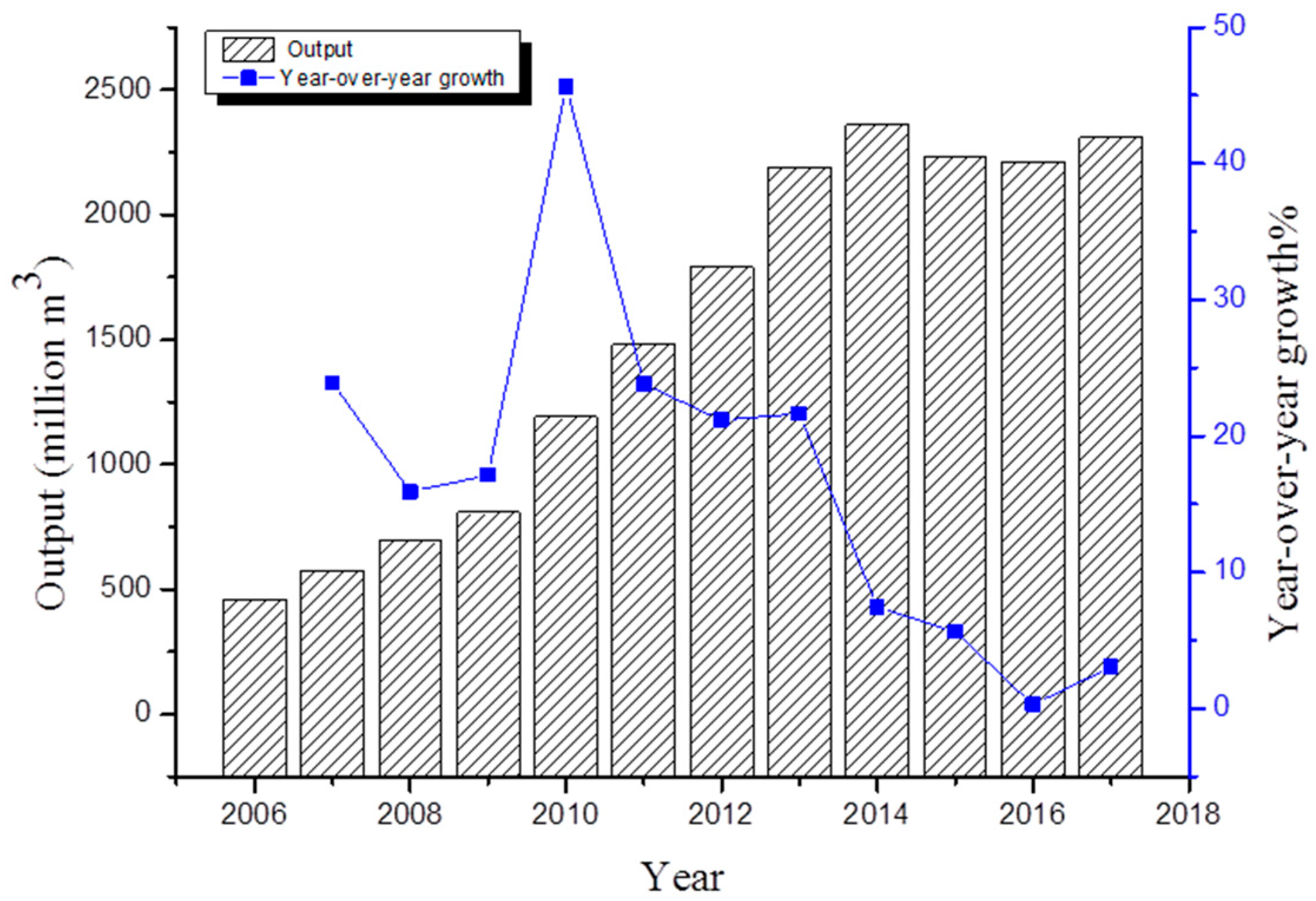
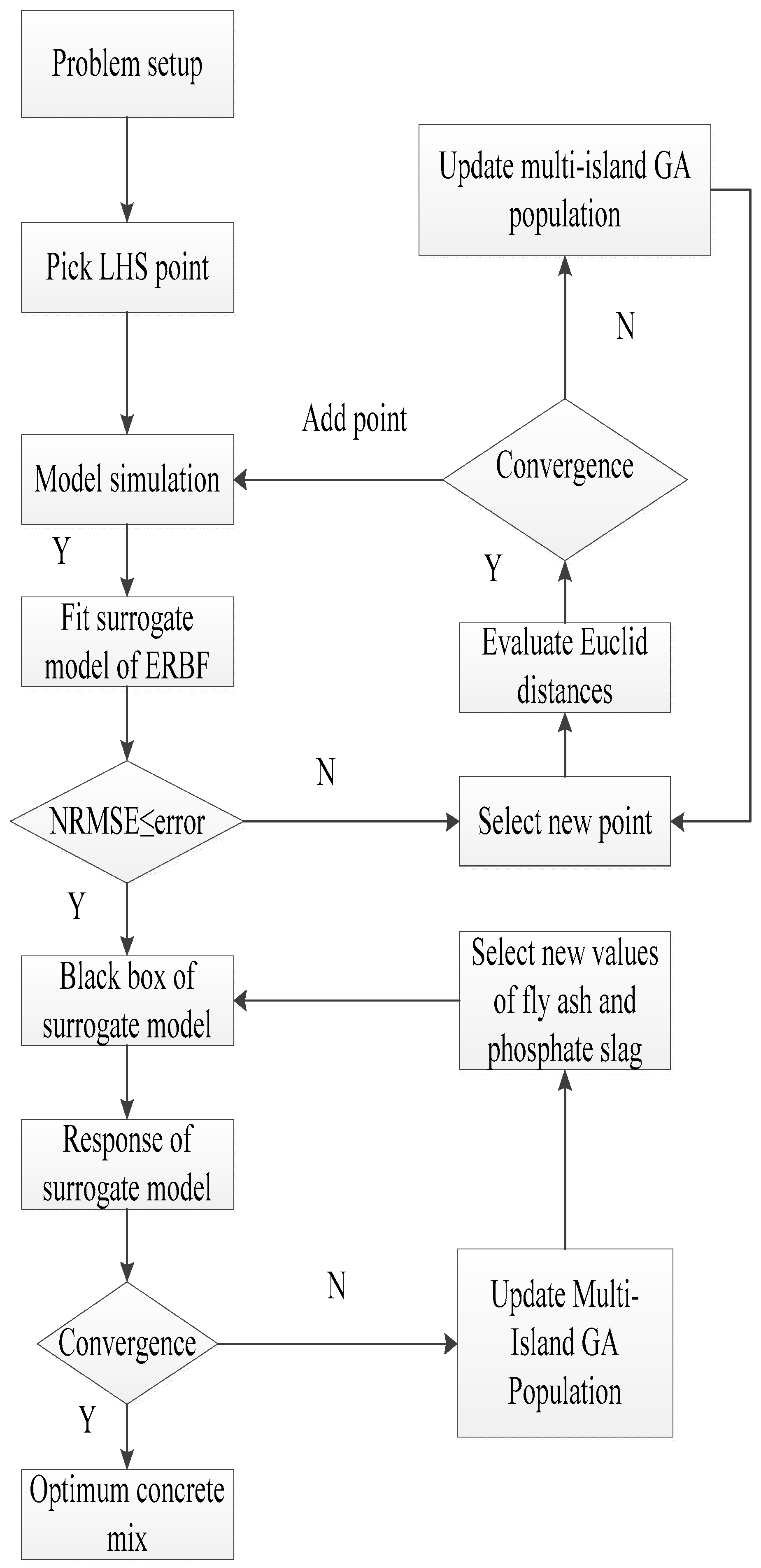

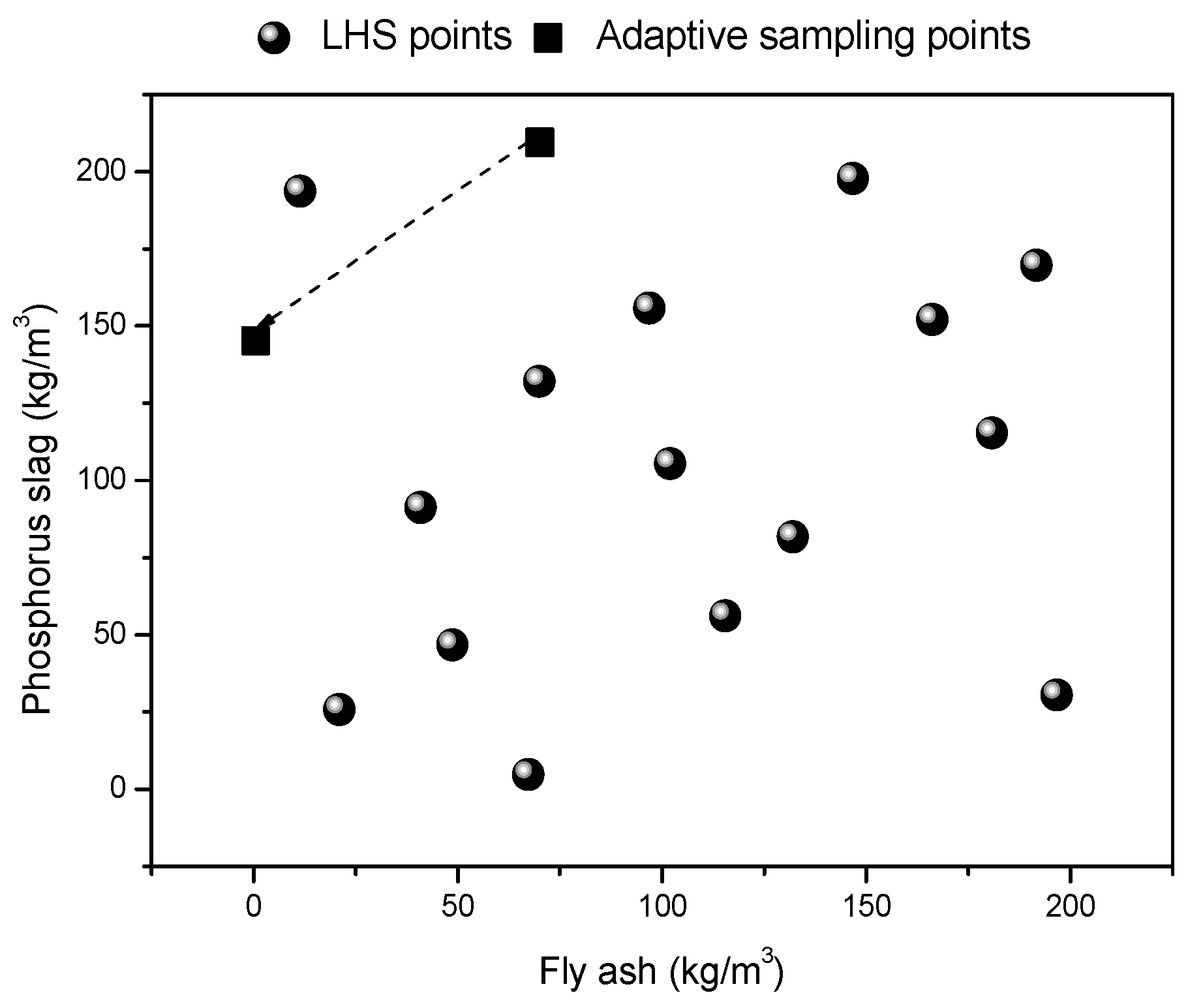
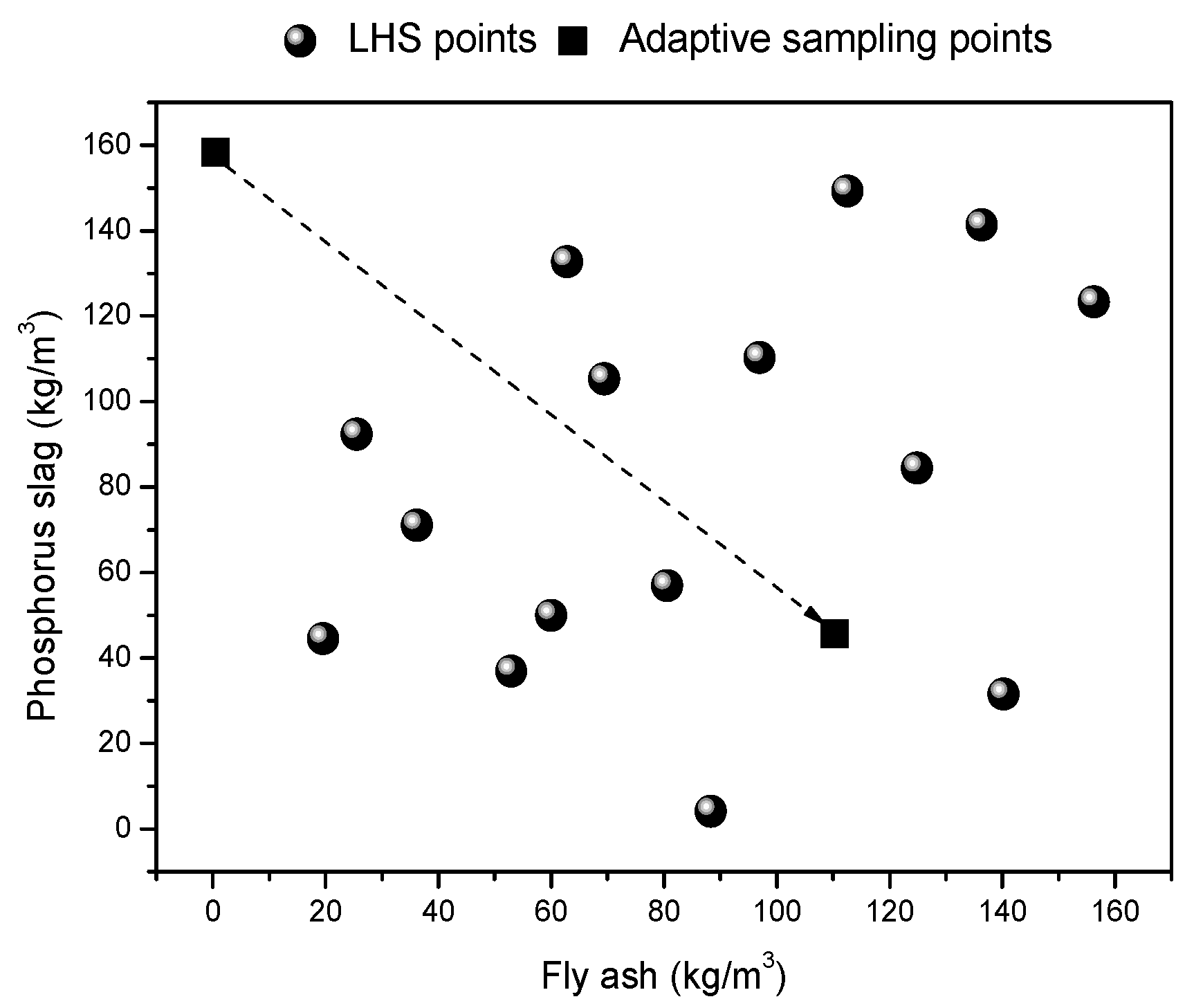
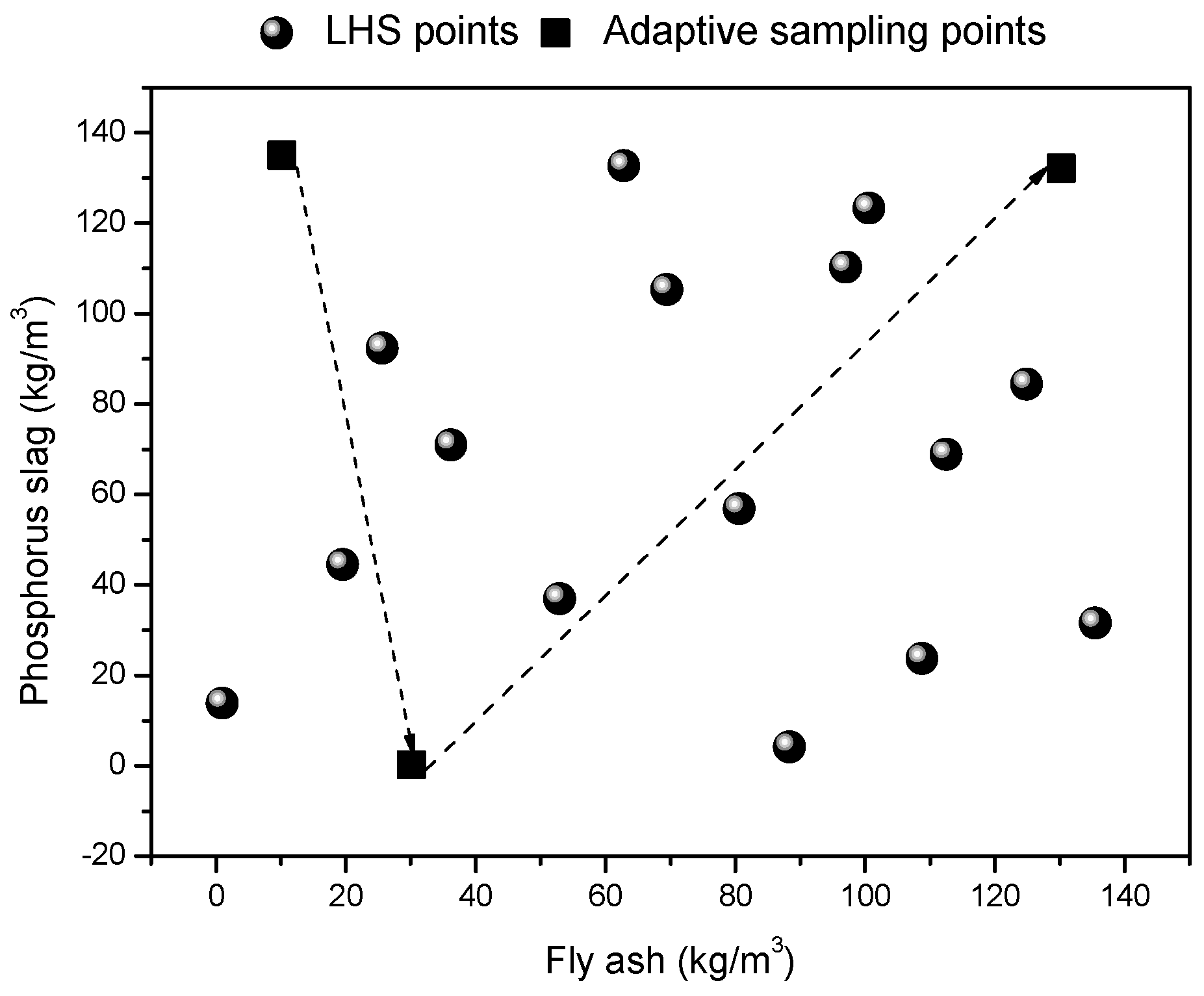
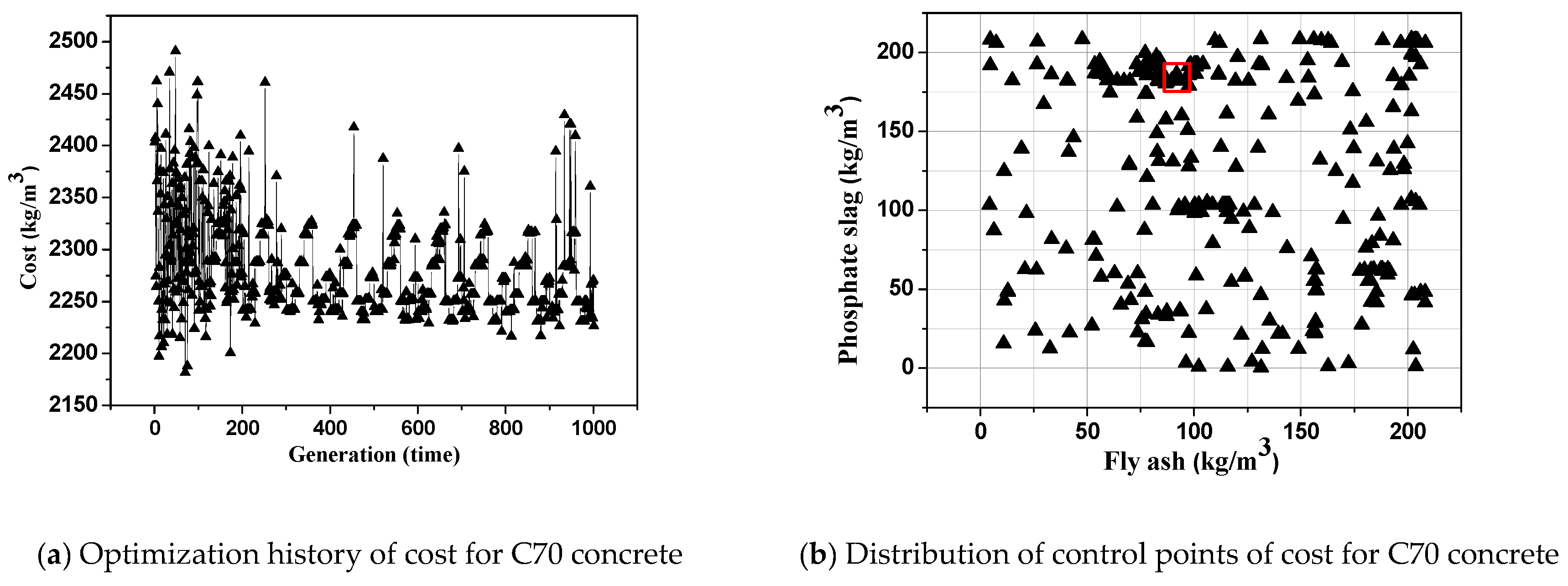
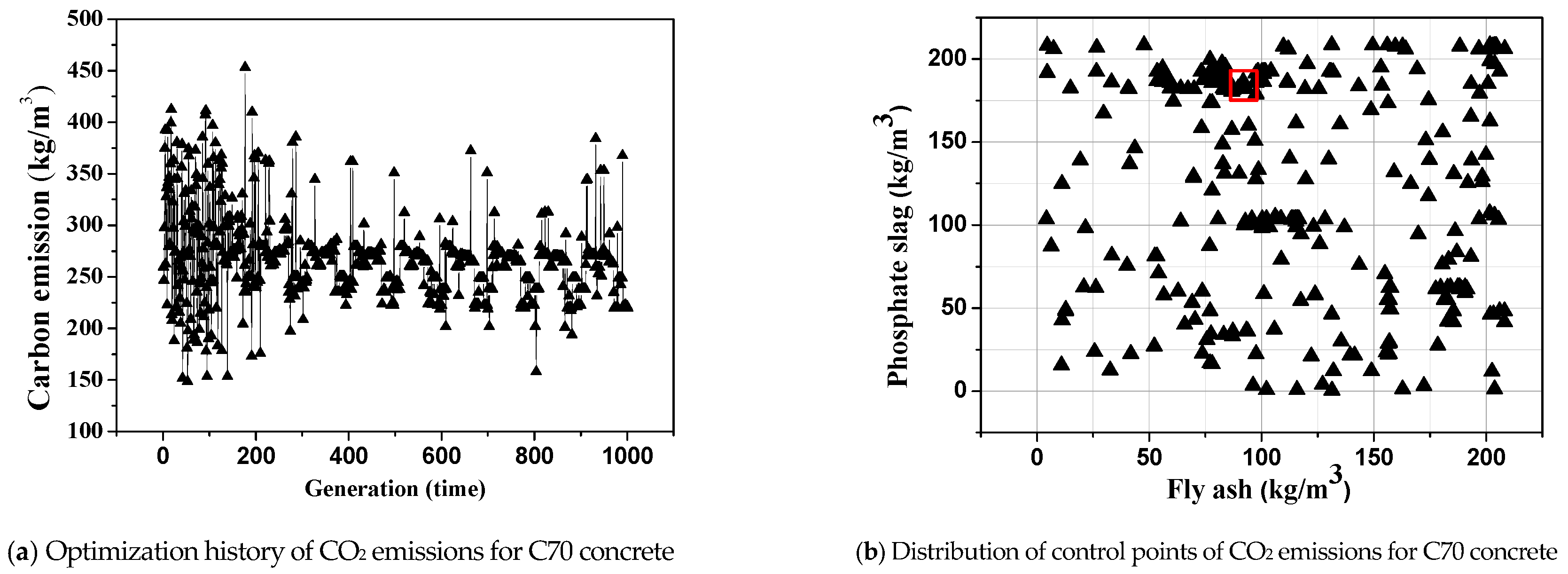
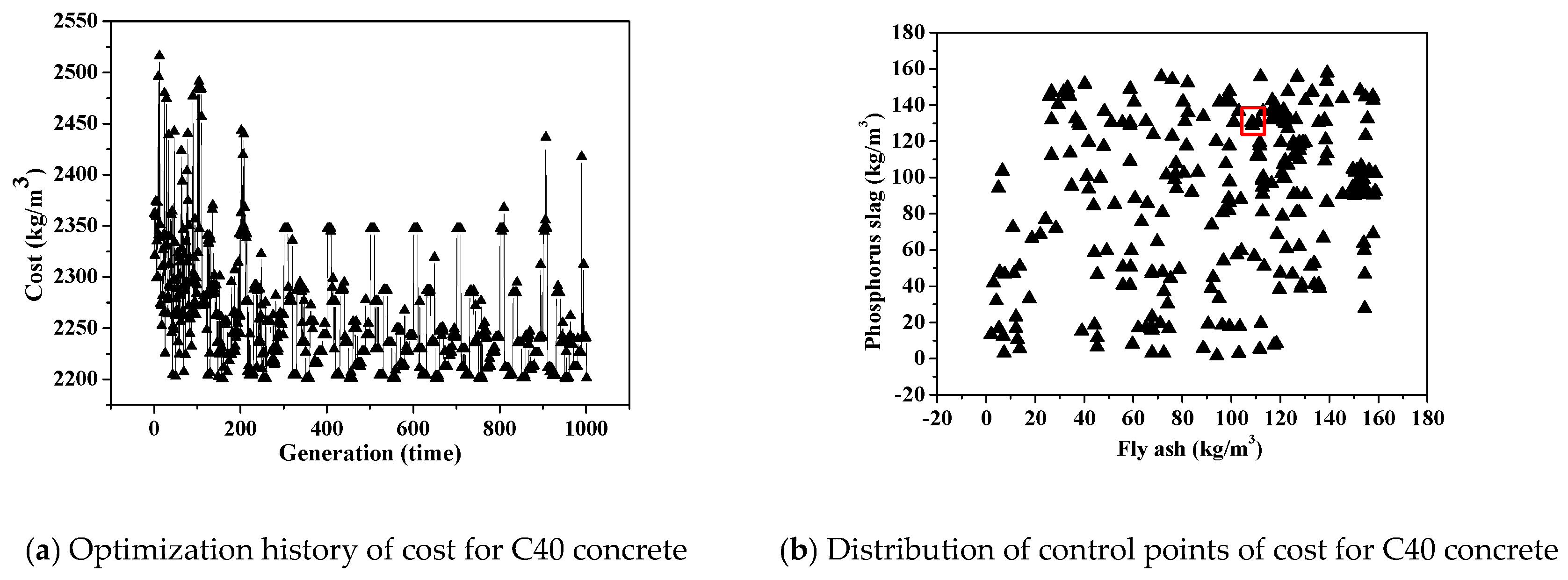
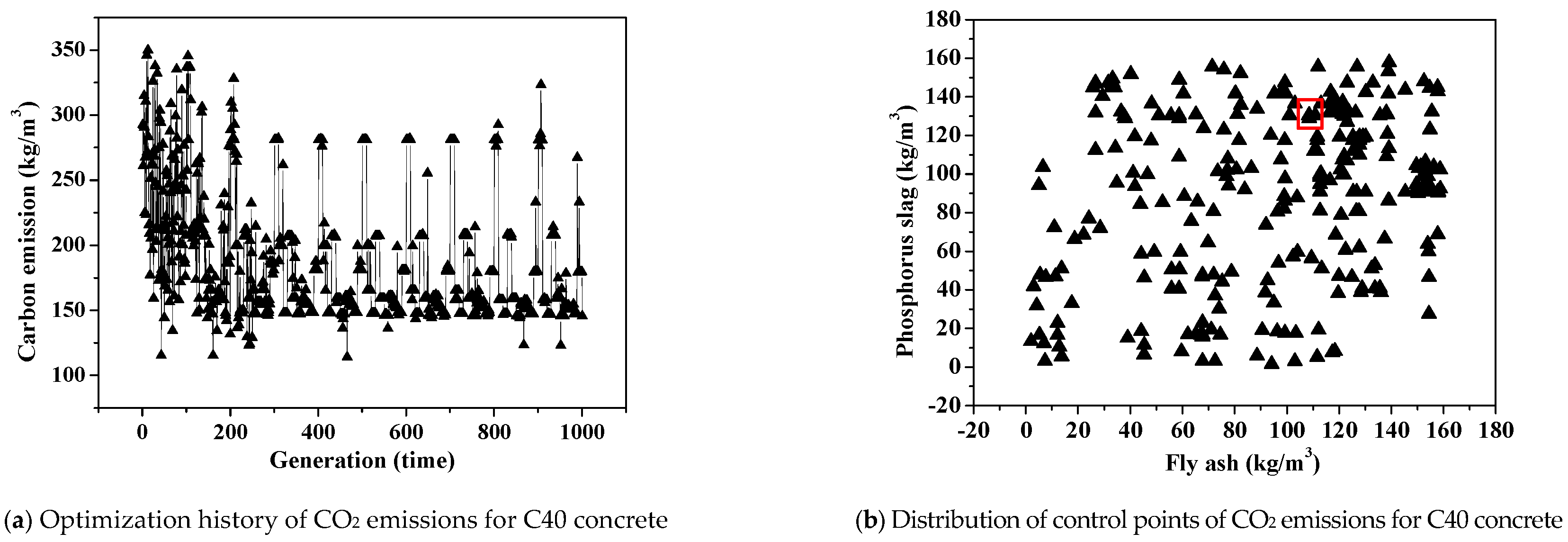
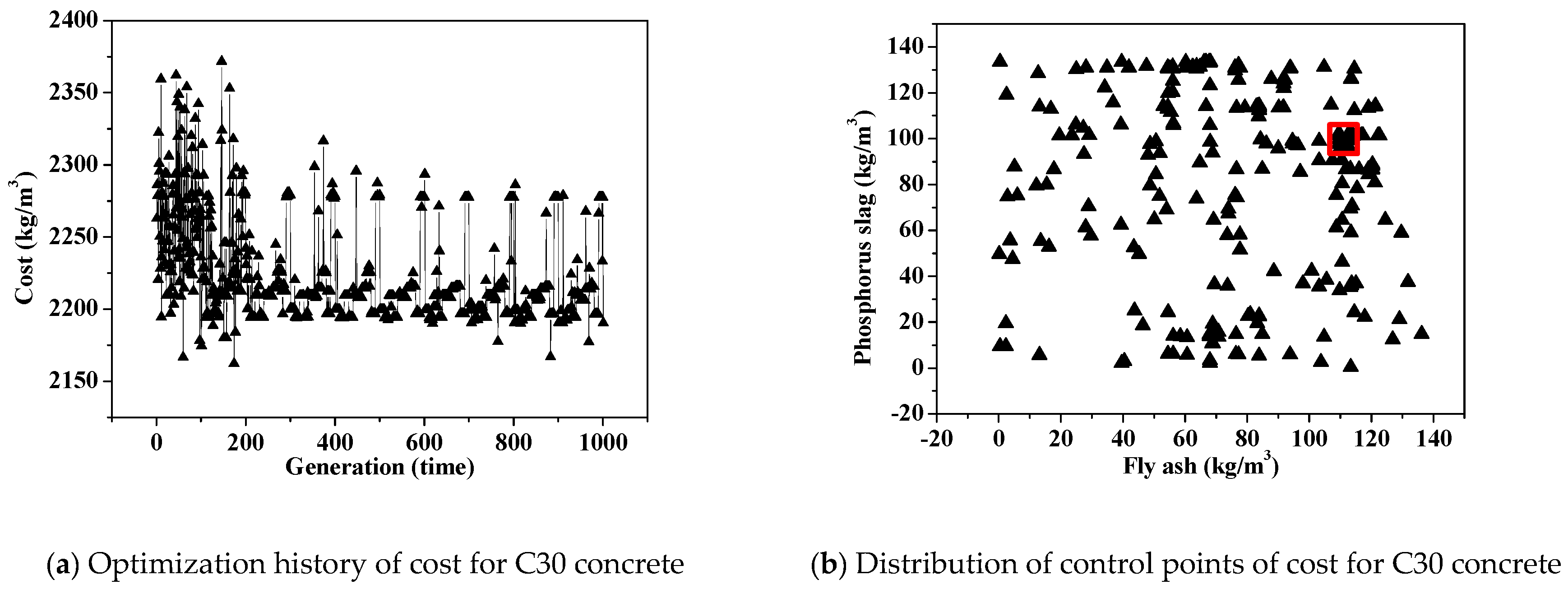
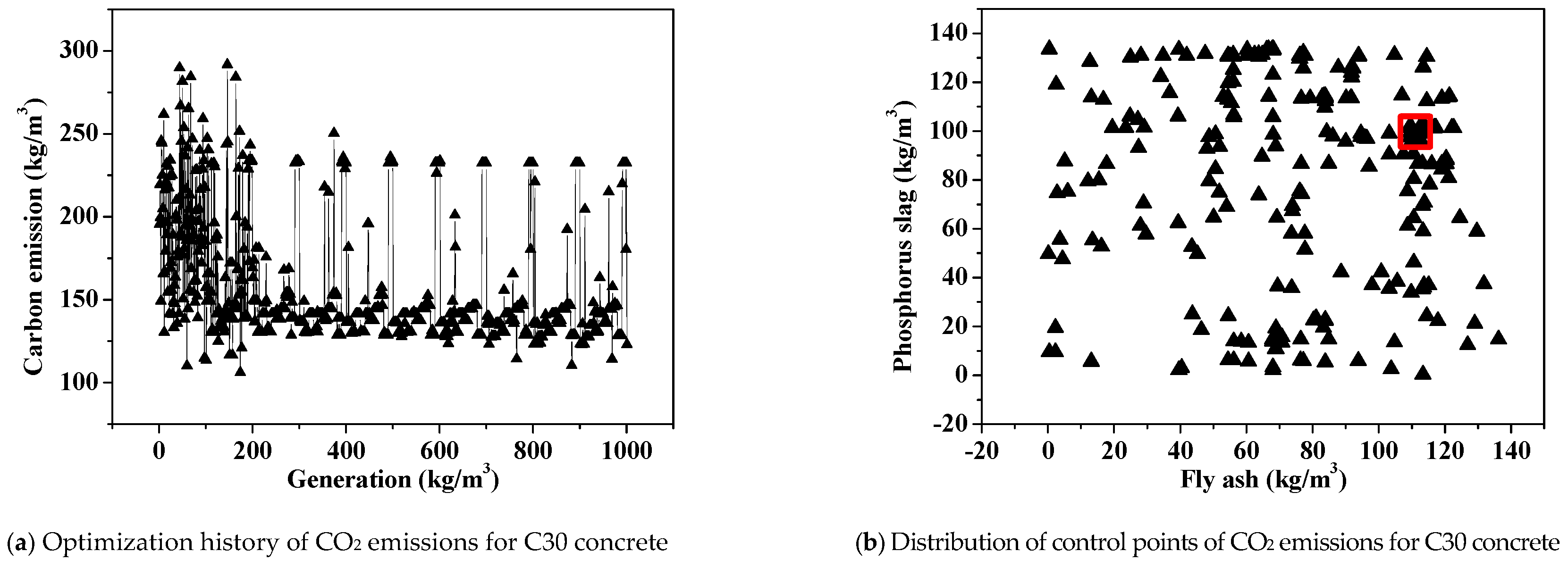
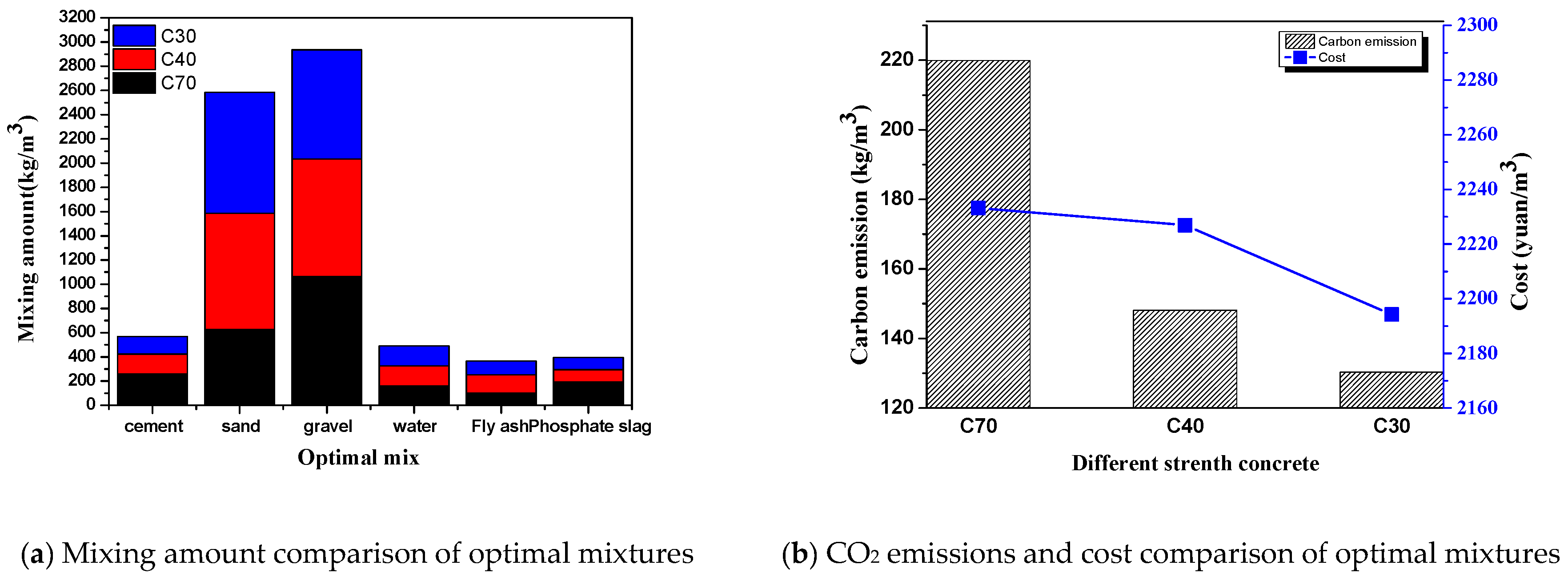
| 0 | |||
| 0 | |||
| 0 | |||
| 0 |
| Materials and Energy Name | Emission Factor | Unit | Source of Date |
|---|---|---|---|
| Cement | 0.604 | kgCO2/kg | (Li, 2014) [36] |
| Coarse aggregate | 2.9 × 10−3 | kgCO2/kg | (Kawai et al., 2005) [37] |
| Fine aggregate | 3.7 × 10−3 | kgCO2/kg | (Kawai et al., 2005) [37] |
| Water | 0.213 × 10−3 | kgCO2/kg | (Wang, 2009) [30] |
| Fly ash | 0.350 × 10−3 | kgCO2/kg | (Chen et al., 2010) [38] |
| Phosphorous slag | 0.320 × 10−3 | kgCO2/kg | (Crossin, 2015) [39] |
| Diesel | 74.1 | KgCO2/GJ | (CECS374: 2014) [40] |
| South China power grid | 0.714 | KgCO2/(kWh) | (CECS374: 2014) [40] |
| Strength | Cementitious Material (kg/m3) | Cement (kg/m3) | Fly Ash (kg/m3) | Phosphorous Slag (kg/m3) | Water (kg/m3) | Water Cement Ratio | Water-Reducing Agent (kg/m3) | Sand (kg/m3) | Gravel (kg/m3) |
|---|---|---|---|---|---|---|---|---|---|
| C70 | 550 | 350 | 100 | 100 | 160 | 0.29 | 4.4 | 625 | 1065 |
| C40 | 420 | 310 | 60 | 50 | 165 | 0.46 | 7.6 | 960 | 970 |
| C30 | 360 | 240 | 60 | 60 | 165 | 0.46 | 6 | 1000 | 900 |
| Number | C70 | C40 | C30 | |||||||||
|---|---|---|---|---|---|---|---|---|---|---|---|---|
| Fly Ash (kg/m3) | Percentage (%) | Phosphorus Slag (kg/m3) | Percentage (%) | Fly Ash (kg/m3) | Percentage (%) | Phosphorus Slag (kg/m3) | Percentage (%) | Fly Ash (kg/m3) | Percentage (%) | Phosphorus Slag (kg/m3) | Percentage (%) | |
| 1 | 11.39 | 2.07 | 193.72 | 35.22 | 23.55 | 5.61 | 26.16 | 6.23 | 1.00 | 0.28 | 13.83 | 3.84 |
| 2 | 191.72 | 34.86 | 169.73 | 30.86 | 136.35 | 32.46 | 128.21 | 30.53 | 97.04 | 26.96 | 110.25 | 30.62 |
| 3 | 196.65 | 35.75 | 30.41 | 5.53 | 0.89 | 0.21 | 100.72 | 23.98 | 135.50 | 37.64 | 31.56 | 8.77 |
| 4 | 180.74 | 32.86 | 115.33 | 20.97 | 82.58 | 19.66 | 95.07 | 22.64 | 124.91 | 34.70 | 84.39 | 23.44 |
| 5 | 21.05 | 3.83 | 25.77 | 4.69 | 104.96 | 24.99 | 35.93 | 8.56 | 25.60 | 7.11 | 92.36 | 25.66 |
| 6 | 67.32 | 12.24 | 4.74 | 0.86 | 114.10 | 27.17 | 125.54 | 29.89 | 52.96 | 14.71 | 36.91 | 10.25 |
| 7 | 69.97 | 12.72 | 132.11 | 24.02 | 15.16 | 3.61 | 115.34 | 27.46 | 80.60 | 22.39 | 56.88 | 15.80 |
| 8 | 115.47 | 21.00 | 56.12 | 10.20 | 64.75 | 15.42 | 65.47 | 15.59 | 100.60 | 27.94 | 123.34 | 34.26 |
| 9 | 48.76 | 8.87 | 46.69 | 8.49 | 51.35 | 12.23 | 91.06 | 21.68 | 19.56 | 5.43 | 44.48 | 12.35 |
| 10 | 146.70 | 26.67 | 197.84 | 35.97 | 99.31 | 23.64 | 81.69 | 19.45 | 108.80 | 30.22 | 23.70 | 6.58 |
| 11 | 40.96 | 7.45 | 91.21 | 16.58 | 74.96 | 17.85 | 7.58 | 1.80 | 112.54 | 31.26 | 68.90 | 19.14 |
| 12 | 101.97 | 18.54 | 105.44 | 19.17 | 124.13 | 29.55 | 48.80 | 11.62 | 62.84 | 17.45 | 132.67 | 36.85 |
| 13 | 96.93 | 17.62 | 155.71 | 28.31 | 43.40 | 10.33 | 11.57 | 2.75 | 36.19 | 10.05 | 71.02 | 19.73 |
| 14 | 166.20 | 30.22 | 152.11 | 27.66 | 60.16 | 14.32 | 39.69 | 9.45 | 69.47 | 19.30 | 105.28 | 29.24 |
| 15 | 132.07 | 24.01 | 81.74 | 14.86 | 35.60 | 8.48 | 59.73 | 14.22 | 88.36 | 24.54 | 4.14 | 1.15 |
| 16 | 70.10 | 12.75 | 209.50 | 38.09 | 0.50 | 0.12 | 158.30 | 37.69 | 10.20 | 2.83 | 135.00 | 37.50 |
| 17 | 0.50 | 0.09 | 145.30 | 26.42 | 110.30 | 26.26 | 45.60 | 10.86 | 130.20 | 36.17 | 132.10 | 36.69 |
| 18 | / | / | / | / | / | / | / | / | 30.10 | 8.36 | 0.200 | 0.06 |
| Number | Fcu,k = 70 | Fcu,k = 40 | Fcu,k = 30 | ||||||
|---|---|---|---|---|---|---|---|---|---|
| Fcu,1 | Cost (yuan/m3) | CO2 Emissions (kg/m3) | Fcu,2 | Cost (yuan/m3) | CO2 Emissions (kg/m3) | Fcu,3 | Cost (yuan/m3) | CO2 Emissions (kg/m3) | |
| 1 | 76.18 | 2324.66 | 289.69 | 42.31 | 2334.63 | 261.38 | 43.66 | 2357.84 | 287.44 |
| 2 | 47.80 | 2205.84 | 168.62 | 52.92 | 2260.79 | 185.50 | 34.42 | 2211.57 | 137.49 |
| 3 | 73.29 | 2307.98 | 273.84 | 48.04 | 2287.75 | 213.57 | 32.38 | 2236.79 | 168.67 |
| 4 | 62.11 | 2255.53 | 219.71 | 46.41 | 2259.28 | 184.14 | 33.46 | 2210.06 | 136.12 |
| 5 | 70.21 | 2444.96 | 413.66 | 59.79 | 2328.69 | 254.91 | 55.11 | 2279.46 | 206.89 |
| 6 | 77.11 | 2425.77 | 394.23 | 59.32 | 2350.03 | 277.09 | 51.88 | 2300.81 | 229.08 |
| 7 | 76.65 | 2326.96 | 292.48 | 59.61 | 2313.86 | 240.03 | 49.35 | 2259.64 | 191.95 |
| 8 | 80.51 | 2350.13 | 316.68 | 38.93 | 2205.82 | 129.31 | 29.60 | 2188.70 | 123.53 |
| 9 | 78.03 | 2406.70 | 375.77 | 60.53 | 2369.60 | 297.07 | 48.67 | 2317.32 | 249.01 |
| 10 | 65.17 | 2215.79 | 181.50 | 33.57 | 2207.31 | 130.65 | 32.98 | 2242.03 | 193.77 |
| 11 | 74.53 | 2380.09 | 346.99 | 35.78 | 2219.39 | 142.92 | 27.67 | 2220.43 | 156.84 |
| 12 | 72.94 | 2322.91 | 288.54 | 49.59 | 2269.80 | 194.48 | 34.38 | 2217.41 | 146.43 |
| 13 | 65.23 | 2288.54 | 253.10 | 47.87 | 2336.85 | 263.40 | 40.32 | 2283.88 | 215.33 |
| 14 | 53.52 | 2238.63 | 202.20 | 58.71 | 2285.65 | 210.77 | 39.09 | 2232.55 | 162.71 |
| 15 | 68.28 | 2318.05 | 283.75 | 36.87 | 2348.04 | 275.29 | 36.16 | 2298.82 | 227.28 |
| 16 | 89.58 | 2302.67 | 273.78 | 63.82 | 2482.92 | 239.75 | 43.24 | 2268.51 | 186.09 |
| 17 | 76.11 | 2422.70 | 384.25 | 44.84 | 2272.38 | 223.12 | 23.32 | 2158.75 | 93.77 |
| 18 | / | / | / | / | / | / | 32.21 | 2360.55 | 276.30 |
| Item | C70 | C40 | C30 | |||
|---|---|---|---|---|---|---|
| Reference Mix | Optimal Mix | Reference Mix | Optimal Mix | Reference Mix | Optimal Mix | |
| Cement (kg/m3) | 350.00 | 259.12 | 310.00 | 164.00 | 240.00 | 145.05 |
| Sand (kg/m3) | 625.00 | 625.00 | 960.00 | 960.00 | 1000.00 | 1000.00 |
| Gravel (kg/m3) | 1065.00 | 1065.00 | 970.00 | 970.00 | 900.00 | 900.00 |
| Water (kg/m3) | 160.00 | 160.00 | 165.00 | 165.00 | 165.00 | 165.00 |
| Fly ash (kg/m3) | 100.00 | 99.27 | 60.00 | 152.99 | 60.00 | 113.56 |
| Phosphate slag (kg/m3) | 100.00 | 191.61 | 50.00 | 103.01 | 60.00 | 101.39 |
| Carbon emission (kg/m3) | 773.56 | 219.95 | 261.60 | 148.09 | 205.50 | 130.33 |
| Cost (yuan/m3) | 2326.76 | 2233.16 | 2353.51 | 2226.95 | 2272.91 | 2194.23 |
© 2019 by the authors. Licensee MDPI, Basel, Switzerland. This article is an open access article distributed under the terms and conditions of the Creative Commons Attribution (CC BY) license (http://creativecommons.org/licenses/by/4.0/).
Share and Cite
Cen, X.; Wang, Q.; Shi, X.; Su, Y.; Qiu, J. Optimization of Concrete Mixture Design Using Adaptive Surrogate Model. Sustainability 2019, 11, 1991. https://doi.org/10.3390/su11071991
Cen X, Wang Q, Shi X, Su Y, Qiu J. Optimization of Concrete Mixture Design Using Adaptive Surrogate Model. Sustainability. 2019; 11(7):1991. https://doi.org/10.3390/su11071991
Chicago/Turabian StyleCen, Xiaoqian, Qingyuan Wang, Xiaoshuang Shi, Yan Su, and Jingsi Qiu. 2019. "Optimization of Concrete Mixture Design Using Adaptive Surrogate Model" Sustainability 11, no. 7: 1991. https://doi.org/10.3390/su11071991
APA StyleCen, X., Wang, Q., Shi, X., Su, Y., & Qiu, J. (2019). Optimization of Concrete Mixture Design Using Adaptive Surrogate Model. Sustainability, 11(7), 1991. https://doi.org/10.3390/su11071991






